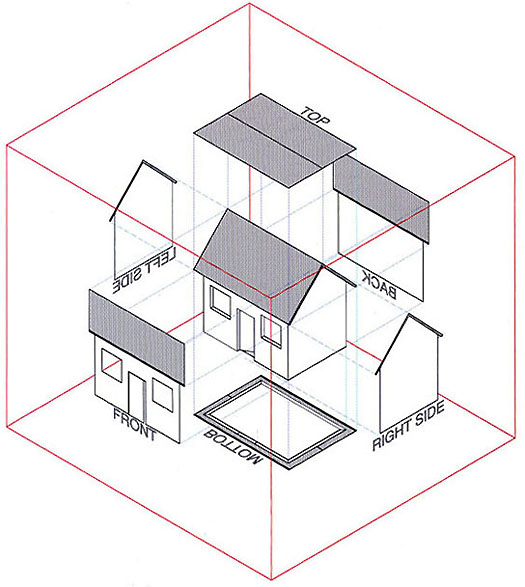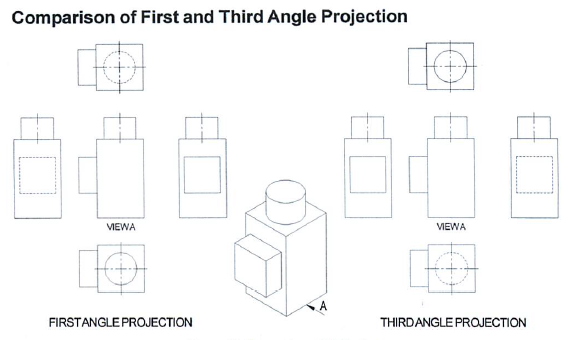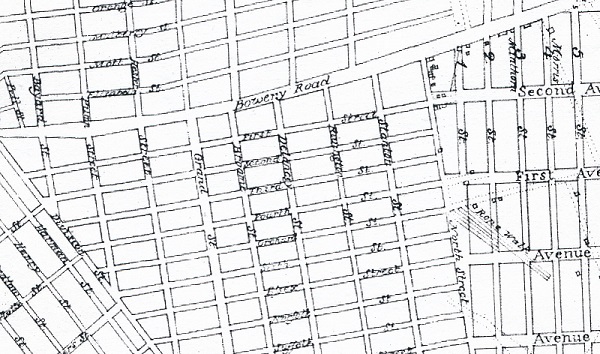Orthogonal plan
The term 'orthogonal' refers to objects that, in Euclidean geometry, are related by perpendicularity. The etymology of the term is the Greek ‘ortho’ meaning ‘right’, and ‘gon’ meaning ‘angled’.
Orthogonal projection is a drawing technique used to represent three-dimensional objects as a series of two-dimensional 'flat' drawings in which there is no perspective.
Orthographic projection is a type of 'parallel' projection in which the four orthogonal views of an object are shown. The orthographic projection commonly used in the UK is called first angle projection.
Buildings are commonly depicted orthogonally by a series of elevations and plans.
The orthographic projection commonly used in the UK is called first angle projection.
The term 'orthogonal plan' may also refer to a type of urban design layout that consists of mostly square street blocks with straight streets intersecting at right angles. This forms a grid pattern, commonly referred to as a ‘grid plan’ or ‘gridiron’.
Orthogonal plans for urban design date back to antiquity, and contributed to the building of some the earliest planned cities. The layout is commonly credited to the 5th-century Greek philosopher Hippodamus, who championed this method of urban planning in his Hippodamian Plan. However, archaeologists have cast doubt on his true claim having found evidence of such plans (more accurately referred to as Milesian layouts) in ancient Egypt.
The regular orthogonal plans of the ancient Greek and Hellenic societies influenced the ancient Romans, who established design principles that are often followed to this day; particularly the work of the engineer Vitruvius.
In a modern context, grid plan urbanism has come to be closely associated with America and recently-redesigned cities such as Barcelona (outside of its historic core).
Although orthogonal plans can help with orientation and enable directness of route due to frequent intersections, the infrastructure cost associated with regular grid patterns is often higher than for patterns with discontinuous streets.
[edit] Related articles on Designing Buildings
Featured articles and news
RTPI leader to become new CIOB Chief Executive Officer
Dr Victoria Hills MRTPI, FICE to take over after Caroline Gumble’s departure.
Social and affordable housing, a long term plan for delivery
The “Delivering a Decade of Renewal for Social and Affordable Housing” strategy sets out future path.
A change to adoptive architecture
Effects of global weather warming on architectural detailing, material choice and human interaction.
The proposed publicly owned and backed subsidiary of Homes England, to facilitate new homes.
How big is the problem and what can we do to mitigate the effects?
Overheating guidance and tools for building designers
A number of cool guides to help with the heat.
The UK's Modern Industrial Strategy: A 10 year plan
Previous consultation criticism, current key elements and general support with some persisting reservations.
Building Safety Regulator reforms
New roles, new staff and a new fast track service pave the way for a single construction regulator.
Architectural Technologist CPDs and Communications
CIAT CPD… and how you can do it!
Cooling centres and cool spaces
Managing extreme heat in cities by directing the public to places for heat stress relief and water sources.
Winter gardens: A brief history and warm variations
Extending the season with glass in different forms and terms.
Restoring Great Yarmouth's Winter Gardens
Transforming one of the least sustainable constructions imaginable.
Construction Skills Mission Board launch sector drive
Newly formed government and industry collaboration set strategy for recruiting an additional 100,000 construction workers a year.
New Architects Code comes into effect in September 2025
ARB Architects Code of Conduct and Practice available with ongoing consultation regarding guidance.
Welsh Skills Body (Medr) launches ambitious plan
The new skills body brings together funding and regulation of tertiary education and research for the devolved nation.
Paul Gandy FCIOB announced as next CIOB President
Former Tilbury Douglas CEO takes helm.
UK Infrastructure: A 10 Year Strategy. In brief with reactions
With the National Infrastructure and Service Transformation Authority (NISTA).

























